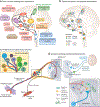Endogenous and Exogenous Opioids in Pain
- PMID: 29852083
- PMCID: PMC6428583
- DOI: 10.1146/annurev-neuro-080317-061522
Endogenous and Exogenous Opioids in Pain
Abstract
Opioids are the most commonly used and effective analgesic treatments for severe pain, but they have recently come under scrutiny owing to epidemic levels of abuse and overdose. These compounds act on the endogenous opioid system, which comprises four G protein-coupled receptors (mu, delta, kappa, and nociceptin) and four major peptide families (β-endorphin, enkephalins, dynorphins, and nociceptin/orphanin FQ). In this review, we first describe the functional organization and pharmacology of the endogenous opioid system. We then summarize current knowledge on the signaling mechanisms by which opioids regulate neuronal function and neurotransmission. Finally, we discuss the loci of opioid analgesic action along peripheral and central pain pathways, emphasizing the pain-relieving properties of opioids against the affective dimension of the pain experience.
Keywords: analgesia; neuroanatomy; opioid; pain; perception; signaling.
Figures



References
-
- al-Rodhan NR, Yaksh TL, Kelly PJ. 1992. Comparison of the neurochemistry of the endogenous opioid systems in two brainstem pain-processing centers. Stereotact. Funct. Neurosurg. 59:15–19 - PubMed
-
- Altier C, Khosravani H, Evans RM, Hameed S, Peloquin JB, et al. 2006. ORL1 receptor-mediated internalization of N-type calcium channels. Nat. Neurosci. 9:31–40 - PubMed
Publication types
MeSH terms
Substances
Grants and funding
LinkOut - more resources
Full Text Sources
Other Literature Sources
Medical
Research Materials

